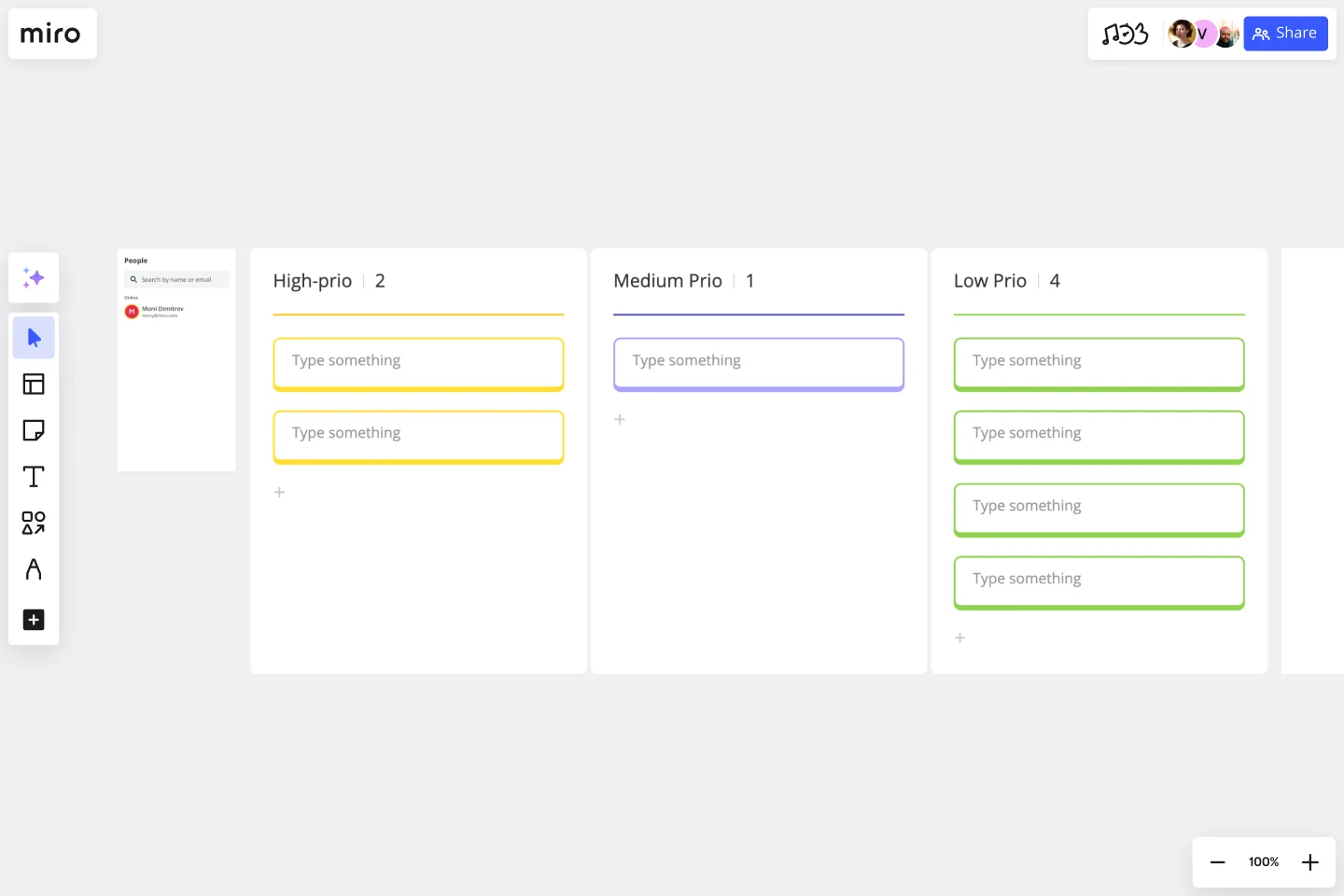Daily Schedule Template
Elevate your productivity and focus on what matters with the Daily Schedule Template.
About the Daily Schedule Template
Efficient time management is essential for a well-structured routine. The Daily Schedule Template is an excellent tool for planning your day. This template lets you map your tasks and organize priorities on a Kanban board. It is meticulously designed to help you manage your day systematically.
The Daily Schedule Template is like a planner that empowers you to allocate time for specific events, prioritize tasks, and maintain a clear overview of your daily commitments.
How to use the daily schedule template
Add tasks: Add cards to your template and double-click them to add task details and priority.
Add context: Elevate your schedule by incorporating artifacts into your board, such as links, images, or other visual aids.
Color-code for clarity: Use color-coded labels to distinguish between high, medium, and low prio tasks.
Why should you use a daily schedule template?
Structured routine: Organize your day, providing a clear roadmap for daily activities.
Time optimization: Allocate time efficiently, ensuring a balanced distribution of tasks and responsibilities.
Prioritization: Identify and prioritize essential tasks, preventing overwhelm and promoting focus.
Goal alignment: Align your daily schedule with broader goals, enhancing productivity and achieving milestones.
Adaptability: The template's flexibility allows quick adjustments to meet changing priorities or unforeseen events.
How does the template accommodate changing priorities throughout the day?
You can adapt your daily schedule quickly to accommodate changing priorities or unforeseen events.
Can I integrate my daily schedule with broader goals?
Absolutely. Align your daily schedule with more general objectives, ensuring your daily activities contribute to long-term success.
Get started with this template right now.
Communication Matrix Template
Works best for:
Project Management, Project Planning, Meetings
The Communication Matrix Template serves as a structured framework for businesses and projects to streamline their communication strategies. By mapping out types of communication, their purposes, mediums, frequencies, and intended audiences, the template ensures that every stakeholder remains informed and aligned. One of its key benefits is the enhanced clarity it brings. By laying out the specifics of each communication touchpoint, the matrix eliminates ambiguity, ensuring that all involved parties know exactly what to expect and when leading to more efficient collaboration and fewer misunderstandings.
Fishbone RCA
Works best for:
Problem solving, Strategy
Use the Fishbone RCA template to conduct a thorough root cause analysis (RCA) for any problem. This template helps you break down complex issues into manageable categories, enabling you to identify the underlying causes. It's an effective tool for improving processes, solving problems, and preventing future issues.
Impact/Effort Matrix Template
Works best for:
Project Management, Strategic Planning, Prioritization
Growing organizations have countless to-do’s and only so many hours in a day (or weeks before a big launch) to get them done. That’s where an impact effort matrix comes in. It gives you a quick visual guide to help prioritize your tasks and know exactly what’s worth doing. Using our template, you can create a matrix that organizes your activities into four main categories: quick wins that are low effort, effort-intensive projects that provide long-term returns, fill-ins that are low effort but low value, and time-wasters.
Incident Management Process Flowchart Template
The Incident Management Process Flowchart Template in Miro is designed to streamline and clarify the process of managing incidents within an organization. This template serves as a visual guide that outlines the steps involved in incident management, from the initial declaration to the final review. It is a living document, continuously evolving based on feedback and lessons learned from past incidents, ensuring that the process remains up-to-date with best practices. By defining incidents as disruptions requiring a coordinated response to restore service levels, the template emphasizes the importance of a structured, organized, and timely approach. It covers various phases such as Incident Declaration, Assessment, Response, Communication, and Review, providing a clear framework for teams to follow.
Editorial Calendar Template
Works best for:
Marketing, Strategic Planning, Project Planning
If your company is like most, content is a big thing. You create more of it (and a lot faster) than you create almost anything else. It includes blogs, newsletters, social media posts, ads, and more—and it requires ideating, writing, editing, and publishing. That’s why every content team needs an editorial calendar. The template will let you easily create a calendar that empowers your team to plan strategically, keep things organized (by content type, writer, channel, and delivery date), and finalize/post all content on schedule.
B2B – Product Journey Map & User Network
Works best for:
Planning, Product Management
The B2B Product Journey Map & User Network template helps product teams visualize and understand the complex journey of B2B customers. By mapping user interactions, pain points, and touchpoints across the buyer's journey, this template provides insights into user behavior and preferences. With sections for analyzing user needs, identifying opportunities, and optimizing user experiences, it enables teams to design tailored solutions and drive customer satisfaction. This template serves as a strategic tool for enhancing B2B product offerings and maximizing customer value.
